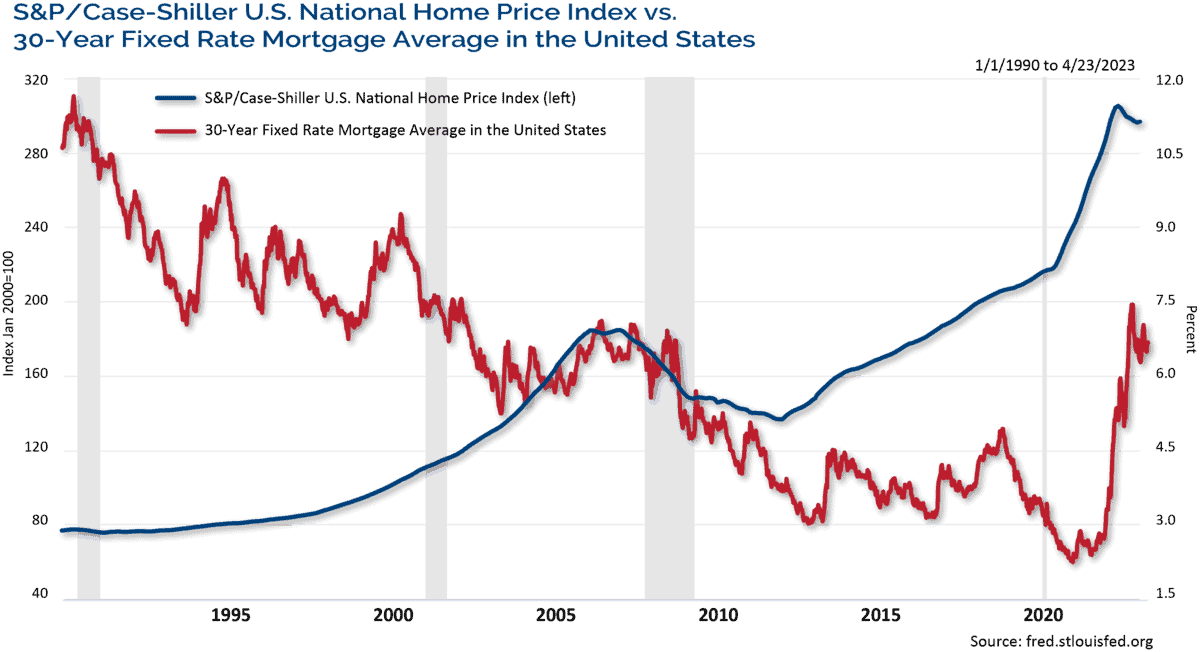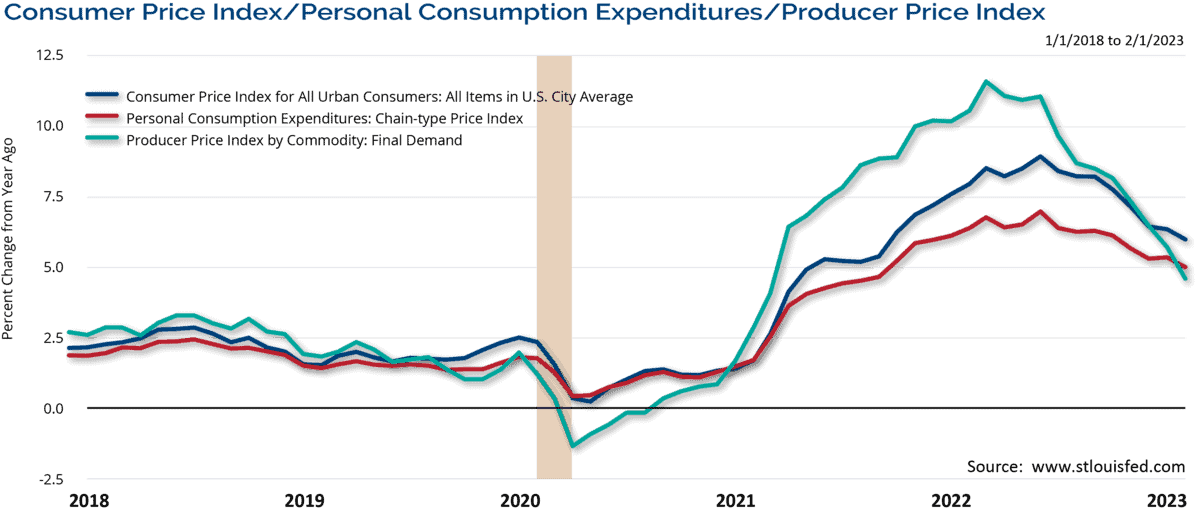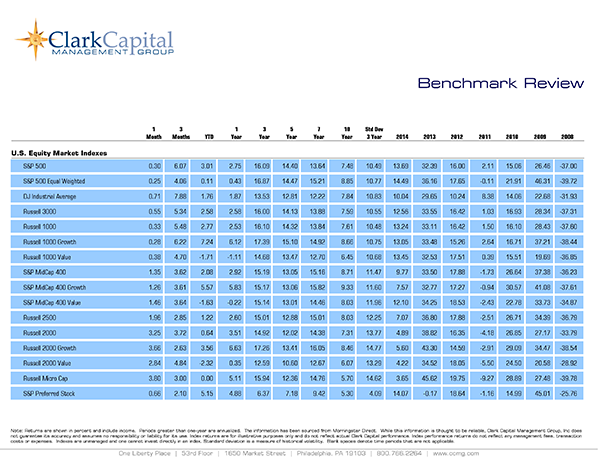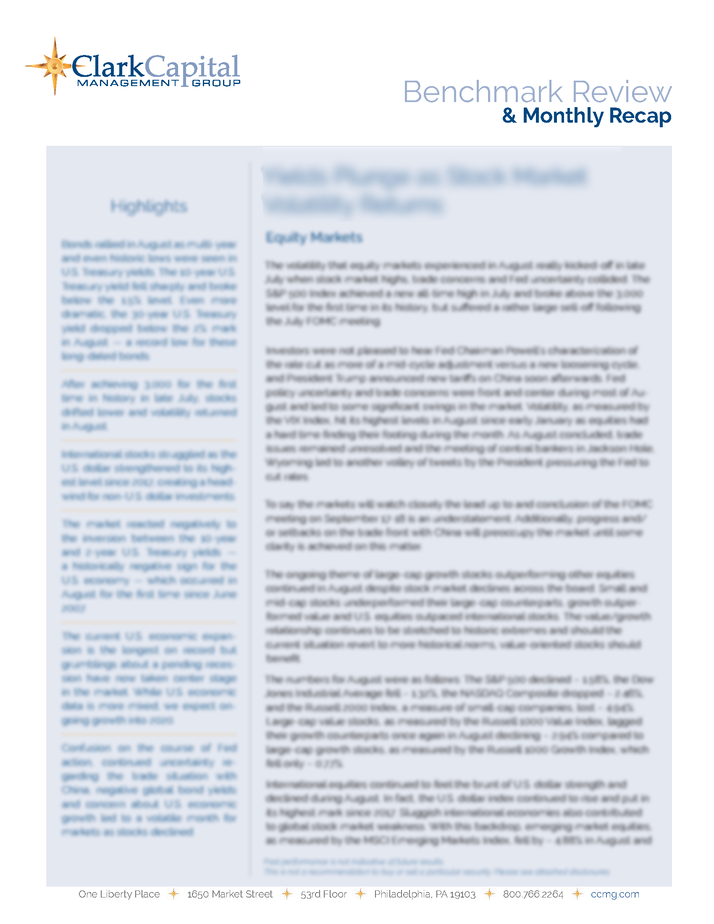Mixed Markets See Large-Caps and Bonds Advance; SMID Declined
HIGHLIGHTS:
- Concerns around regional banks caused stocks to slump and volatility to rise in the middle of March, but from that point on, equities have advanced, and volatility has declined through April.
- The VIX Index, a measure of stock market volatility, rose to just below 30 on an intraday basis in mid-March, but it moved steadily lower from that point. It closed April at 15.78 – a 52-week low.
- Large-cap stocks made gains in April, while small and mid-cap companies declined. International stocks were mixed as well with developed markets posting gains, but emerging markets sliding lower.
- The yield on the 10-year U.S. Treasury closed April at 3.44% compared to March’s close at 3.48%. With the exception of municipal bonds, fixed income markets advanced in April.
- Outside of the job market, economic data continued to show slowing activity. However, inflation readings also continued to improve in April, which could move the Fed toward the end of this rate hike cycle soon.
EQUITY MARKETS
In a modest change to the recent trend, large-cap value stocks outperformed large-cap growth companies in April, but the trend of large-caps outperforming small and mid-caps persisted during the month. Developed international stocks gained, but emerging market equities fell in what was a disperse return environment in April. See Table 1 for equity results for April and year to date.
Table 1
| Index | April 2023 | YTD 2023 |
|---|---|---|
| S&P 500 | 1.56% | 9.17% |
| S&P 500 Equal Weight | 0.34% | 3.28% |
| DJIA | 2.57% | 3.53% |
| Russell 3000 | 1.07% | 8.32% |
| NASDAQ Comp. | 0.07% | 17.12% |
| Russell 2000 | -1.80% | 0.89% |
| MSCI ACWI ex U.S. | 1.74% | 8.72% |
| MSCI Emerging Mkts Net | -1.13% | 2.78% |
Source: Bloomberg For illustrative purposes only. Indexes are unmanaged and have been provided for comparison purposes only. No fees or expenses are reflected. You cannot invest directly in an index.
The S&P 500 Index posted a solid gain of 1.56% in April but looking at the S&P 500 on an equal-weighted basis showed the average stock only gained 0.34%. Recall the S&P 500 Index is a market-cap weighted index and is becoming more and more dominated by mega-cap Technology companies. Those mega-cap Technology companies have done better than the average stock and by quite a significant margin when looking at year-to-date results.
The tech-heavy NASDAQ Composite was only modestly higher in April but still has the strongest results so far this year. Meanwhile, the Russell 2000 Index, a measure of small-cap companies, continued to struggle in April and the strong gains at the start of the year have been largely wiped out with recent weakness in this space.
On a year-to-date basis, significant divergences existed in the stock market. Large-cap growth stocks have been the clear winner so far in 2023. Despite gaining only 0.99% for the month, the Russell 1000 Growth Index was up 15.49% for the year to date. By contrast, the Russell 1000 Value Index gained a modestly better 1.51% in April, but it stands with a year-to-date gain of only 2.53%. Growth performed modestly better than value on a relative basis in small and mid-caps in April. However, small and mid-caps were both down during the month regardless of style as large-cap performance dominated the month and year to date.
Fixed Income
Yields have been on a roller coaster ride so far in 2023. In January, yields dropped rather sharply, but February saw yields rise dramatically as some inflation readings were “hot” and concerns grew that the Fed might need to raise rates even higher than previously expected. Equally as dramatic was the drop again in yields in March as there was a flight to quality with concerns about some regional banks. In contrast, April was somewhat calm as yields finished April only modestly lower compared to March. (Not to say there was not some volatility during the month itself.) The 10-year U.S. Treasury closed March at 3.48% and April at 3.44%. Interestingly, the 30-year U.S. Treasury yield closed March and April at an identical 3.67%. Outside of the 1-month T-Bill, shorter-term rates (1-year and under) generally rose in April, but longer-dated bond yields generally declined. The inversion of the yield curve continues. Please see Table 2 for fixed income returns for April and YTD.
Table 2
| Index | April 2023 | YTD 2023 |
|---|---|---|
| Bloomberg U.S. Agg | 0.61% | 3.59% |
| Bloomberg U.S. Credit | 0.79% | 4.26% |
| Bloomberg U.S. High Yield | 1.00% | 4.60% |
| Bloomberg Muni | -0.23% | 2.54% |
| Bloomberg 30-year U.S. TSY | 0.16% | 6.16% |
| Bloomberg U.S. TSY | 0.54% | 3.56% |
Source: Bloomberg. For illustrative purposes only. Indexes are unmanaged and have been provided for comparison purposes only. No fees or expenses are reflected. You cannot invest directly in an index.
We believe the move higher in rates in 2022 has largely run its course at the longer end of the yield curve and we expect the 10-year yield to move lower as we go through 2023. While volatile, that has occurred so far in 2023 with longer-dated yields declining, which has set up a better return environment for bonds. In previous Fed rate hike cycles, longer rates have started to come down before the Fed has stopped raising the Federal Funds rate and that pattern has played out this year as well.
We maintain our opinion that we are in the late innings of this rate hike cycle. We also maintain our long-standing position favoring credit versus pure rate exposure in this interest rate environment. Municipal bonds have been somewhat expensive on a relative basis, so weakness in this part of the market was not unexpected in April. Finally, we believe the role bonds play in a portfolio, to provide stable cash flows and to help offset the volatility of stocks in the long run, has not changed.
Economic Data and Outlook
The U.S. economy continued to grow in the first quarter of 2023 albeit at a more modest pace than expected and experienced in the second half of 2022. The advance or preliminary reading of Q1 2023 GDP came in at a 1.1% annualized rate. Expectations were calling for a reading of 1.9% and this compares to Q4 2022 GDP of 2.6%. We expect growth to slow down later in the year and we believe the risk of a mild recession has increased and is about as likely as a soft landing. The first quarter ended on a strong note when it came to the job market as non-farm payrolls increased by 236,000 in March, surpassing expectations of 230,000.
Prior month payrolls were revised higher as well. The unemployment rate ticked lower to 3.5%, beating expectations and improving from February’s level of 3.6%. Furthermore, the labor force participation rate increased, when expectations were calling for no change from the prior month. Chart 1 shows that the labor force participation rate has been steadily declining for years (driven in large part by baby boomers retiring), but the large drop due to the pandemic has started to steadily improve and is getting closer to pre-pandemic levels. The unemployment rate is just above the 3.4% mark set in January — the lowest unemployment rate since 1969.
Chart 1.
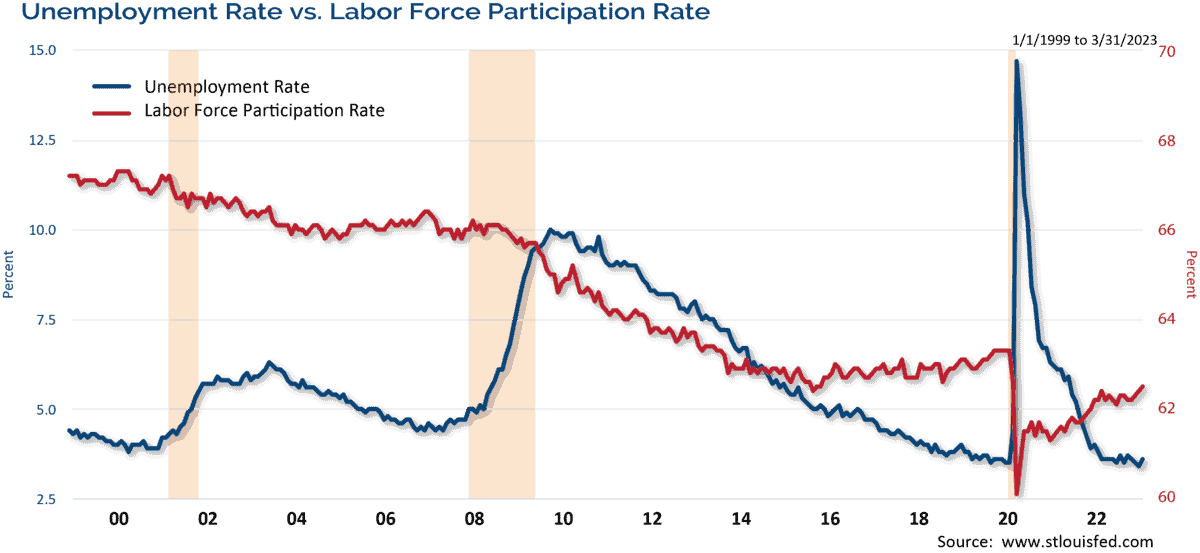 For illustrative purposes only. For illustrative purposes only. Past performance is not indicative of future results. Projections or other forward looking statements regarding future financial performance of markets are only predictions and actual events or results may differ materially.
For illustrative purposes only. For illustrative purposes only. Past performance is not indicative of future results. Projections or other forward looking statements regarding future financial performance of markets are only predictions and actual events or results may differ materially.
More people returning to the labor force would help the mismatch in job seekers versus job openings with millions more open jobs than people looking for work. The JOLTS reading on job openings was below expectations in February and dropped below 10 million, which could be signaling some initial slowdown in hiring. The Fed would likely view this as a positive development with rate hikes starting to slow broader economic activity and therefore inflationary pressures.
Wages climbed by 4.2% on an annual basis in March, which was below expectations of 4.3%, and lower than the 4.6% gain in February — another reading the Fed is likely applauding. The Fed aggressively raising rates over the last year is expected to raise unemployment, but Fed rate increases so far have not resulted in significant weakness in the job market outside of the Technology sector. We will watch developments in the job market closely with consumer spending accounting for about 70% of U.S. economic activity.
Housing continues to be impacted by higher interest rates due to the direct impact on mortgage rates. Interest rates have been volatile this year and after housing activity was largely better than expected in February, it was more mixed in March. Building permits, considered a leading indicator for housing, missed expectations and dropped sharply lower in March to a 1.413 million annual pace from the 1.550 million rate in February. Housing starts dropped to a 1.420 million annual rate from the prior month’s 1.432 million pace, but it did surpass expectations. Existing home sales missed expectations at a 4.44 million pace when a reading of 4.50 million was anticipated and this was below the 4.55 million pace from the prior month. New home sales, however, stood out with a 683,000 annual pace in March compared to estimates of 632,000 and the prior month’s 623,000.
Housing prices were expected to slightly decline on a year over year basis by -0.05% in February, but they instead held onto a modest annual gain of 0.36% based on the S&P CoreLogic CS 20-City Index for February. Home prices rose by 2.58% on an annual basis in January. Declining home prices has been the clear trend over the last several months as mortgage rates have increased dramatically and slowed housing activity. Chart 2 shows the National Home Price Index, which saw strong gains as mortgage rates were low, but reflected those home prices cooling as mortgage rates have more than doubled.
Chart 2.
The ISM Manufacturing Index showed contraction for the 4th consecutive month in February with a reading of 47.7 – a modest improvement from January’s reading of 47.4, but below expectations of 48.0. (The reading for March marked a 5th straight month of contraction at 46.3 – the lowest level since May 2020.) The ISM Non-Manufacturing Index, which covers the much larger service industries in the U.S. economy, continued to show solid expansion with a reading of 55.1 in February – better than expectations of 54.5 and just modestly lower than the 55.2 mark from January. Recall that ISM readings above 50 indicate expansion and below 50 signal contraction.
Retail sales (ex. auto and gas) dropped -0.3% in March, but this was half the expected decline of -0.6%. The prior month’s reading was revised lower from a flat reading to a -0.5% decline. The preliminary University of Michigan Sentiment reading for April improved to 63.5 from 62 and expectations of 62.1. The Conference Board’s Leading Index continued to decline and fell by -1.2% in March, much worse than the expected -0.7% drop and the prior month was revised downward to -0.5% from -0.3%.
After disappointing January inflation data hit the market in February, inflation readings covering February, released in March were largely positive. The headline Consumer Price Index for February dropped to 6.0% as expected from 6.4%. The headline Producer Price Index fell to a 4.6% annual increase, which was much better than expectations of 5.4% and the prior month’s mark of 5.7%. The Fed’s preferred measure of inflation, the Personal Consumption Expenditures Index, dropped to 5.0% in February from a revised lower 5.3% in January and this beat expectations of 5.1%. Similarly, the core reading of the PCE Index (the primary way the Fed looks at inflation) showed a monthly increase of 0.3%, which was better than the 0.4% expected and an annual increase of 4.6%, a modest drop from the 4.7% increase from January. Chart 3 shows that the trend for inflation continues lower.
The Fed’s aggressive rate hikes impacted capital markets and the economy last year. Markets reset valuations based on higher interest rates and lower corporate earnings expectations in this rate-tightening cycle. However, we believe we are in the late innings of this rate hike cycle and the S&P 500 has now posted gains in two consecutive quarters.
Although economic growth picked up in the second half of 2022 and we believe that momentum has continued early in the new year, we expect growth to slow later in 2023 and believe the odds of a mild recession are about 50/50. However, the job market has remained resilient and is a critical component of our overall economy, leading us to the conclusion that any economic slowdown would be modest. As always, we believe it is imperative for investors to stay focused on their long-term goals and not let short-term swings in the market derail them from their longer-term objectives.
Investment Implications
Clark Capital’s Top-Down, Quantitative Strategies
The markets remain very resilient with the S&P 500 closing just off its high for the year. Credit conditions are stable and trends in global indices continue to improve. Our credit models are fully risk-on, so our tactical bias is overweight equity and credit.
Clark Capital’s Bottom-Up, Fundamental Strategies
Margin expectations are moving up, and the antifragile growth monopolies are reasserting themselves as well-managed, profit focused enterprises. Our exposure to those names has been increasing and many of them still appear attractively priced. Year to date, four companies in the S&P 500 Index represent 60% of the gain including Meta Platforms, Inc., Nvidia Corp., Apple Inc., and Microsoft Corp. We believe the market continues to reward profitability over valuation and large to mega-cap at the expense of small-caps.
Within the fixed income portfolios, the focus was on taking advantage of the stable markets and continuing to move into what we believe are higher quality, more stable names.
ECONOMIC DATA
| Event | Period | Estimate | Actual | Prior | Revised |
|---|---|---|---|---|---|
| ISM Manufacturing | Mar | 47.5 | 46.3 | 47.7 | — |
| ISM Services Index | Mar | 54.4 | 51.2 | 55.1 | — |
| Change in Nonfarm Payrolls | Mar | 230k | 236k | 311k | 326k |
| Unemployment Rate | Mar | 3.60% | 3.50% | 3.60% | — |
| Average Hourly Earnings YoY | Mar | 4.30% | 4.20% | 4.60% | — |
| JOLTS Job Openings | Feb | 10500k | 9931k | 10824k | 10563k |
| PPI Final Demand MoM | Mar | 0.00% | -0.50% | -0.10% | 0.00% |
| PPI Final Demand YoY | Mar | 3.00% | 2.70% | 4.60% | 4.90% |
| PPI Ex Food and Energy MoM | Mar | 0.20% | -0.10% | 0.00% | 0.20% |
| PPI Ex Food and Energy YoY | Mar | 3.40% | 3.40% | 4.40% | 4.80% |
| CPI MoM | Mar | 0.20% | 0.10% | 0.40% | — |
| CPI YoY | Mar | 5.10% | 5.00% | 6.00% | — |
| CPI Ex Food and Energy MoM | Mar | 0.40% | 0.40% | 0.50% | — |
| CPI Ex Food and Energy YoY | Mar | 5.60% | 5.60% | 5.50% | — |
| Retail Sales Ex Auto and Gas | Mar | -0.60% | -0.30% | 0.00% | -0.50% |
| Industrial Production MoM | Mar | 0.20% | 0.40% | 0.00% | 0.20% |
| Building Permits | Mar | 1450k | 1413k | 1524k | 1550k |
| Housing Starts | Mar | 1400k | 1420k | 1450k | 1432k |
| New Home Sales | Mar | 632k | 683k | 640k | 623k |
| Existing Home Sales | Mar | 4.50m | 4.44m | 4.58m | 4.55m |
| Leading Index | Mar | -0.70% | -1.20% | -0.30% | -0.50% |
| Durable Goods Orders | Mar P | 0.70% | 3.20% | -1.00% | -1.20% |
| GDP Annualized QoQ | 1Q A | 1.90% | 1.10% | 2.60% | — |
| U. of Mich. Sentiment | Apr P | 62.1 | 63.5 | 62 | — |
| Personal Income | Mar | 0.20% | 0.30% | 0.30% | — |
| Personal Spending | Mar | -0.10% | 0.00% | 0.20% | 0.10% |
| S&P CoreLogic CS 20-City YoY NSA | Feb | -0.05% | 0.36% | 2.55% | 2.58% |
Source: Bloomberg
Past performance is not indicative of future results. The opinions referenced are as of the date of publication and are subject to change due to changes in the market or economic conditions and may not necessarily come to pass. Material presented has been derived from sources considered to be reliable and has not been independently verified by us or our personnel. Nothing herein should be construed as a solicitation, recommendation or an offer to buy, sell or hold any securities, other investments or to adopt any investment strategy or strategies. Investors must make their own decisions based on their specific investment objectives and financial circumstances. Investing involves risk, including loss of principal.
Clark Capital Management Group is an investment adviser registered with the U.S. Securities and Exchange Commission. Registration does not imply a certain level of skill or training. More information about Clark Capital Management Group’s advisory services can be found in its Form ADV which is available upon request.
Fixed income securities are subject to certain risks including, but not limited to: interest rate (changes in interest rates may cause a decline in market value or an investment), credit, prepayment, call (some bonds allow the issuer to call a bond for redemption before it matures), and extension (principal repayments may not occur as quickly as anticipated, causing the expected maturity of a security to increase).
Clark Capital utilizes a proprietary investment model to assist with the construction of the strategy and to assist with making investment decisions. Investments selected using this process may perform differently than expected as a result of the factors used in the model, the weight placed on each factor, and changes from the factors’ historical trends. There is no guarantee that Clark Capital’s use of a model will result in effective investment decisions.
Non-investment-grade debt securities (high-yield/junk bonds) may be subject to greater market fluctuations, risk of default or loss of income and principal than higher-rated securities.
Foreign securities are more volatile, harder to price and less liquid than U.S. securities. They are subject to different accounting and regulatory standards and political and economic risks. These risks are enhanced in emerging market countries.
The value of investments, and the income from them, can go down as well as up and you may get back less than the amount invested.
Equity securities are subject to price fluctuation and possible loss of principal. Stock markets tend to move in cycles, with periods of rising prices and periods of falling prices. Certain investment strategies tend to increase the total risk of an investment (relative to the broader market). Strategies that concentrate their investments in limited sectors are more vulnerable to adverse market, economic, regulatory, political, or other developments affecting those sectors.
JOLTS is a monthly report by the Bureau of Labor Statistics (BLS) of the U.S. Department of Labor counting job vacancies and separations, including the number of workers voluntarily quitting employment.
The Producer Price Index (PPI) program measures the average change over time in the selling prices received by domestic producers for their output. The prices included in the PPI are from the first commercial transaction for many products and some services.
References to market or composite indices, benchmarks or other measures of relative market performance over a specified period of time (each, an “index”) are provided for your information only. Reference to an index does not imply that the portfolio will achieve returns, volatility or other results similar to that index. The composition of the index may not reflect the manner in which a portfolio is constructed in relation to expected or achieved returns, portfolio guidelines, restrictions, sectors, correlations, concentrations, volatility or tracking error targets, all of which are subject to change. Investors cannot invest directly in an index.
The Bloomberg Barclays U.S. Municipal Index covers the USD-denominated long-term tax exempt bond market. The index has four main sectors: state and local general obligation bonds, revenue bonds, insured bonds and prerefunded bonds.
The Bloomberg US Treasury Index measures US dollar-denominated, fixed-rate, nominal debt issued by the US Treasury. Treasury bills are excluded by the maturity constraint, but are part of a separate Short Treasury Index.
The Dow Jones Industrial Average indicates the value of 30 large, publicly owned companies based in the United States.
The NASDAQ Composite is a stock market index of the common stocks and similar securities listed on the NASDAQ stock market.
The S&P 500 measures the performance of the 500 leading companies in leading industries of the U.S. economy, capturing 80% of U.S. equities.
The S&P 500® Equal Weight Index (EWI) is the equal-weight version of the widely-used S&P 500. The index includes the same constituents as the capitalization weighted S&P 500, but each company in the S&P 500 EWI is allocated a fixed weight – or 0.2% of the index total at each quarterly rebalance.
The University of Michigan Consumer Sentiment Index rates the relative level of current and future economic conditions. There are two versions of this data released two weeks apart, preliminary and revised. The preliminary data tends to have a greater impact. The reading is compiled from a survey of around 500 consumers.
The Russell 1000 Growth Index measures the performance of the large-cap growth segment of the U.S. equity universe. It includes those Russell 1000 Index companies with higher price-to-book ratios and higher forecasted growth values.
The Russell 1000 Value Index measures the performance of the large-cap value segment of the U.S. equity universe. It includes those Russell 1000 Index companies with lower price-to-book ratios and lower forecasted growth values.
The Russell 2000 Index is a small-cap stock market index that represents the bottom 2,000 stocks in the Russell 3000.
The Russell 3000 Index measures the performance of the 3,000 largest U.S. companies based on total market capitalization, which represents approximately 98% of the investable U.S. equity market.
The 10 Year Treasury Rate is the yield received for investing in a US government issued treasury security that has a maturity of 10 year. The 10 year treasury yield is included on the longer end of the yield curve. Many analysts will use the 10 year yield as the “risk free” rate when valuing the markets or an individual security.
The Bloomberg Barclays U.S. Corporate High-Yield Index covers the U.S. dollar-denominated, non-investment grade, fixed-rate, taxable corporate bond market. Securities are classified as high-yield if the middle rating of Moody’s, Fitch, and S&P is Ba1/BB+/BB+ or below.
The Bloomberg Barclays U.S. Credit Index measures the investment grade, U.S. dollar denominated, fixed-rate taxable corporate and government related bond markets.
The Bloomberg Aggregate Bond Index or “the Agg” is a broad-based fixed-income index used by bond traders and the managers of mutual funds and exchange-traded funds (ETFs) as a benchmark to measure their relative performance.
The 30-Year Treasury is a U.S. Treasury debt obligation that has a maturity of 30 years. The 30-year Treasury used to be the bellwether U.S. bond but now most consider the 10-year Treasury to be the benchmark.
The ISM Non-Manufacturing Index is an index based on surveys of more than 400 non-manufacturing firms’ purchasing and supply executives, within 60 sectors across the nation, by the Institute of Supply Management (ISM). The ISM Non-Manufacturing Index tracks economic data, like the ISM Non-Manufacturing Business Activity Index. A composite diffusion index is created based on the data from these surveys, that monitors economic conditions of the nation.
ISM Manufacturing Index measures manufacturing activity based on a monthly survey, conducted by Institute for Supply Management (ISM), of purchasing managers at more than 300 manufacturing firms.
The MSCI Emerging Markets Index captures large and mid cap representation across 27 Emerging Markets (EM) countries.
The MSCI ACWI ex USA Index captures large and mid cap representation across 22 of 23 Developed Markets (DM) countries (excluding the US) and 27 Emerging Markets (EM) countries*. With 2,359 constituents, the index covers approximately 85% of the global equity opportunity set outside the US
The S&P CoreLogic Case-Shiller 20-City Composite Home Price NSA Index seeks to measures the value of residential real estate in 20 major U.S. metropolitan areas. The U.S. Treasury index is based on the recent auctions of U.S. Treasury bills. Occasionally it is based on the U.S. Treasury’s daily yield curve.
The Consumer Price Index (CPI) measures the change in prices paid by consumers for goods and services. The CPI reflects spending patterns for each of two population groups: all urban consumers and urban wage earners and clerical workers.
In the United States, the Core Personal Consumption Expenditure Price (CPE) Index provides a measure of the prices paid by people for domestic purchases of goods and services, excluding the prices of food and energy.
The VIX Index is a calculation designed to produce a measure of constant, 30-day expected volatility of the U.S. stock market, derived from real-time, mid-quote prices of S&P 500® Index (SPX℠) call and put options. On a global basis, it is one of the most recognized measures of volatility — widely reported by financial media and closely followed by a variety of market participants as a daily market indicator.
The Conference Board’s Leading Indexes are the key elements in an analytic system designed to signal peaks and troughs in the business cycle. The leading, coincident, and lagging economic indexes are essentially composite averages of several individual leading, coincident, or lagging indicators. They are constructed to summarize and reveal common turning point patterns in economic data in a clearer and more convincing manner than any individual component – primarily because they smooth out some of the volatility of individual components.
Gross domestic product (GDP) is the standard measure of the value added created through the production of goods and services in a country during a certain period.
Index returns include the reinvestment of income and dividends. The returns for these unmanaged indexes do not include any transaction costs, management fees or other costs. It is not possible to make an investment directly in any index.
CCM-993
